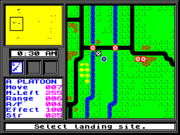Data Design Interactive: Difference between revisions
No edit summary |
a mission based strategy game that is unplayable if you don't read the manual? hmm |
||
| Line 30: | Line 30: | ||
{{Multiple image | align = left | direction = vertical | width = 180 | image1 = PSS Pegasus Bridge Spectrum.png | alt1 = ZX Spectrum version | image2 = PSS Pegasus Bridge Amstrad.png | alt2 = Amstrad CPC version | footer = ''Pegasus Bridge'' on Spectrum (top) and Amstrad (bottom)}} | {{Multiple image | align = left | direction = vertical | width = 180 | image1 = PSS Pegasus Bridge Spectrum.png | alt1 = ZX Spectrum version | image2 = PSS Pegasus Bridge Amstrad.png | alt2 = Amstrad CPC version | footer = ''Pegasus Bridge'' on Spectrum (top) and Amstrad (bottom)}} | ||
Green redesigned and programmed [[Wikipedia:Pegasus Bridge (video game)|''Pegasus Bridge'']] for both ZX Spectrum and [[Wikipedia:Amstrad CPC|Amstrad CPC]] from the original Commodore 64 version.<ref name="Crash 54"/><ref name="Pegasus Bridge"/><ref name="CVG80"/> Originally designed by John Bethell, who had previously created [[Wikipedia:Falklands '82|''Falklands '82'']],<ref name="Pegasus Bridge"/><ref name="Crash 47"/> ''Pegasus Bridge'' is based on the [[Wikipedia:Pegasus Bridge|titular bridge's]] [[Wikipedia:Capture of the Caen canal and Orne river bridges|capture]] by the [[Wikipedia:6th Airlanding Brigade (United Kingdom)|British 6th Airbone Division]] early on 6 June 1944, preceding the [[Wikipedia:Normandy landings|Normandy landings]].<ref name="Crash 48"/><ref name="CVG80"/> The player can control either the British troops, landing and capturing bridges and the [[Wikipedia:Battle of Merville Gun Battery|Merville Battery]], or the German army, defending as many positions as possible from capture for the game's 36 turns.<ref name="Crash 48"/><ref name="YS27"/><ref name="AA27"/> ''Pegasus Bridge'' released in October 1987.<ref name="PCW 639"/> ''CRASH'''s Philippa Irving praised the Spectrum version's design and gameplay, but found it "annoyingly difficult" to control with a keyboard,<ref name="Crash 47"/> and later admitted to encountering a bug that crashed the game prevented her from completing it.<ref name="Crash 51"/> ''Sinclair User'' gave the game a positive review, criticising only the small size of the map window.<ref name="SU71"/> Owen and Audrey Bishop of ''Your Sinclair'' called the game well-researched, but complained about a bug in the Spectrum version that switched which side the player was controlling, as well as the fast speed of in-game messages.<ref name="YS27"/> [[Wikipedia:Amstrad Action|''Amstrad Action'']] called the Amstrad version boring, and criticised the lack of sound and sensitive controls.<ref name="AA27"/> | Green redesigned and programmed [[Wikipedia:Pegasus Bridge (video game)|''Pegasus Bridge'']] for both ZX Spectrum and [[Wikipedia:Amstrad CPC|Amstrad CPC]] from the original Commodore 64 version.<ref name="Crash 54"/><ref name="Pegasus Bridge"/><ref name="CVG80"/> Originally designed by John Bethell, who had previously created [[Wikipedia:Falklands '82|''Falklands '82'']],<ref name="Pegasus Bridge"/><ref name="Crash 47"/> ''Pegasus Bridge'' is based on the [[Wikipedia:Pegasus Bridge|titular bridge's]] [[Wikipedia:Capture of the Caen canal and Orne river bridges|capture]] by the [[Wikipedia:6th Airlanding Brigade (United Kingdom)|British 6th Airbone Division]] early on 6 June 1944, preceding the [[Wikipedia:Normandy landings|Normandy landings]].<ref name="Crash 48"/><ref name="CVG80"/> The player can control either the British troops, landing and capturing bridges and the [[Wikipedia:Battle of Merville Gun Battery|Merville Battery]], or the German army, defending as many positions as possible from capture for the game's 36 turns.<ref name="Crash 48"/><ref name="YS27"/><ref name="AA27"/> ''Pegasus Bridge'' released in October 1987.<ref name="PCW 639"/> ''CRASH'''s Philippa Irving praised the Spectrum version's design and gameplay, but found it "annoyingly difficult" to control with a keyboard,<ref name="Crash 47"/> and later admitted to encountering a bug that crashed the game prevented her from completing it.<ref name="Crash 51"/> ''Sinclair User'' gave the game a positive review, criticising only the small size of the map window.<ref name="SU71"/> Owen and Audrey Bishop of ''Your Sinclair'' called the game well-researched, but complained about a bug in the Spectrum version that switched which side the player was controlling, as well as the fast speed of in-game messages.<ref name="YS27"/> [[Wikipedia:Amstrad Action|''Amstrad Action'']] called the Amstrad version boring, and criticised the lack of sound and sensitive controls.<ref name="AA27"/> | ||
In 1987 Green began developing ''Invasion Force'', an original strategy game set during World War II.<ref name="DDI history"/><ref name="YS51"/> The game does not simulate any specific battle, and each side is labelled only as blue or red. The game is divided into fifteen missions; for each one players select which units they will use, choose where to deploy them, and command them around the map to complete the given objective. Player one controls the invading blue army, and player two or the computer tries to stop them as the red army. The game is heavily depended on its instruction manual, as each mission objective must be decoded using the code sheet found in it.<ref name="Crash 74"/><ref name="YS51"/> ''Invasion Force'' was published by [[Wikipedia:Cases Computer Simulations|Cases Computer Simulations]] for ZX Spectrum in February 1990.<ref name="Crash 73"/> An Amstrad CPC version was planned, but was never released.<ref name="CPC IF"/> The game received positive reviews. Mark Caswell of ''CRASH'' asserted that players new to strategy would find it easy to pick up.<ref name="Crash 74"/> Inversely, Jonathan Davies of ''Your Sinclair'' recommended it for experienced strategy game players looking for a new experience.<ref name="YS51"/> | |||
== References == | == References == | ||
| Line 39: | Line 41: | ||
<ref name="CG15">Hetherington, Tony (June 1986). [https://archive.org/details/Computer_Gamer_Issue_15_1986-06_Argus_Press_GB/page/n38/mode/1up?view=theater "Adventure Reviews"]. [[Wikipedia:Computer Gamer|''Computer Gamer'']]. No. 15. [[Wikipedia:Newsfield|Newsfield Publications Ltd]]. p. 39.</ref> | <ref name="CG15">Hetherington, Tony (June 1986). [https://archive.org/details/Computer_Gamer_Issue_15_1986-06_Argus_Press_GB/page/n38/mode/1up?view=theater "Adventure Reviews"]. [[Wikipedia:Computer Gamer|''Computer Gamer'']]. No. 15. [[Wikipedia:Newsfield|Newsfield Publications Ltd]]. p. 39.</ref> | ||
<ref name="CG16">[https://archive.org/details/Computer_Gamer_Issue_16_1986-07_Argus_Press_GB/page/n28/mode/1up?view=theater ''Astrocade'' advertisement]. [[Wikipedia:Computer Gamer|''Computer Gamer'']]. No. 16, July 1986. [[Wikipedia:Newsfield|Newsfield Publications Ltd]]. p. 29.</ref> | <ref name="CG16">[https://archive.org/details/Computer_Gamer_Issue_16_1986-07_Argus_Press_GB/page/n28/mode/1up?view=theater ''Astrocade'' advertisement]. [[Wikipedia:Computer Gamer|''Computer Gamer'']]. No. 16, July 1986. [[Wikipedia:Newsfield|Newsfield Publications Ltd]]. p. 29.</ref> | ||
<ref name="CG26">A.H. (May 1987). [https://archive.org/details/ | <ref name="CG26">A.H. (May 1987). [https://archive.org/details/Computer_Gamer_Issue_26_1987-05_Argus_Press_GB/page/n70/mode/1up?view=theater "Tobruk"]. [[Wikipedia:Computer Gamer|''Computer Gamer'']]. No. 26. [[Wikipedia:Newsfield|Newsfield Publications Ltd]]. p. 71.</ref> | ||
<ref name="CPC IF">[https://cpcrulez.fr/GamesTest/invasion_force.htm "INVASION FORCE (c) CCS"]. ''CPCrulez''. [https://web.archive.org/web/20230703210650/https://cpcrulez.fr/GamesTest/invasion_force.htm Archived] from the original on 3 July 2023.</ref> | |||
<ref name="Crash 27">Mangram, Lloyd (April 1986). [https://archive.org/details/Crash_No._27_1986-04_Newsfield_GB/page/n111/mode/1up?view=theater "Merely Mangram"]. [[Wikipedia:Crash (magazine)|''CRASH'']]. No. 27. [[Wikipedia:Argus Specialist Publications|Argus Specialist Publications]]. p. 112.</ref> | <ref name="Crash 27">Mangram, Lloyd (April 1986). [https://archive.org/details/Crash_No._27_1986-04_Newsfield_GB/page/n111/mode/1up?view=theater "Merely Mangram"]. [[Wikipedia:Crash (magazine)|''CRASH'']]. No. 27. [[Wikipedia:Argus Specialist Publications|Argus Specialist Publications]]. p. 112.</ref> | ||
<ref name="Crash 28">Kidd, Graeme (May 1986). [https://www.crashonline.org.uk/28/dds.htm "This Little Proggy Went To Market..."]. [[Wikipedia:Crash (magazine)|''CRASH'']] - The Online Edition. No. 28. [[Wikipedia:Newsfield|Newsfield Publications Ltd]]. p. 76. [https://web.archive.org/web/20230625034910/https://www.crashonline.org.uk/28/dds.htm Archived] from the original on 25 June 2023.</ref> | <ref name="Crash 28">Kidd, Graeme (May 1986). [https://www.crashonline.org.uk/28/dds.htm "This Little Proggy Went To Market..."]. [[Wikipedia:Crash (magazine)|''CRASH'']] - The Online Edition. No. 28. [[Wikipedia:Newsfield|Newsfield Publications Ltd]]. p. 76. [https://web.archive.org/web/20230625034910/https://www.crashonline.org.uk/28/dds.htm Archived] from the original on 25 June 2023.</ref> | ||
| Line 50: | Line 53: | ||
<ref name="Crash 51">Irving, Philippa (April 1988). [https://archive.org/details/crash-magazine-51/page/n50/mode/1up?view=theater "Frontline with Philippa Irving"]. [[Wikipedia:Crash (magazine)|''CRASH'']]. No. 51. [[Wikipedia:Newsfield|Newsfield Publications Ltd]]. p. 51.</ref> | <ref name="Crash 51">Irving, Philippa (April 1988). [https://archive.org/details/crash-magazine-51/page/n50/mode/1up?view=theater "Frontline with Philippa Irving"]. [[Wikipedia:Crash (magazine)|''CRASH'']]. No. 51. [[Wikipedia:Newsfield|Newsfield Publications Ltd]]. p. 51.</ref> | ||
<ref name="Crash 54">Irving, Philippa (July 1988). [https://www.crashonline.org.uk/54/frontline.htm "Frontline with Philippa Irving"]. [[Wikipedia:Crash (magazine)|''CRASH'']] - The Online Edition. No. 54. [[Wikipedia:Newsfield|Newsfield Publications Ltd]]. p. 63. [https://web.archive.org/web/20230628053056/https://www.crashonline.org.uk/54/frontline.htm Archived] from the original on 28 June 2023.</ref> | <ref name="Crash 54">Irving, Philippa (July 1988). [https://www.crashonline.org.uk/54/frontline.htm "Frontline with Philippa Irving"]. [[Wikipedia:Crash (magazine)|''CRASH'']] - The Online Edition. No. 54. [[Wikipedia:Newsfield|Newsfield Publications Ltd]]. p. 63. [https://web.archive.org/web/20230628053056/https://www.crashonline.org.uk/54/frontline.htm Archived] from the original on 28 June 2023.</ref> | ||
<ref name="Crash 73">Caswell, Mark (February 1990). [https://archive.org/details/crash-magazine-73/page/n27/mode/1up?view=theater "Cannons, Charges, Strategies..."]. [[Wikipedia:Crash (magazine)|''CRASH'']]. No. 73. [[Wikipedia:Newsfield|Newsfield Publications Ltd]]. p. 28.</ref> | |||
<ref name="Crash 74">Caswell, Mark (March 1990). [https://archive.org/details/crash-magazine-74/page/n41/mode/1up?view=theater "Invasion Force"]. [[Wikipedia:Crash (magazine)|''CRASH'']]. No. 74. [[Wikipedia:Newsfield|Newsfield Publications Ltd]]. p. 42.</ref> | |||
<ref name="CVG75">Badsey, Steve (January 1988). [https://archive.org/details/ComputerAndVideoGamesIssue075Jan88/page/n45/mode/1up?view=theater "Annals of Rome"]. [[Wikipedia:Computer and Video Games|''Computer + Video Games'']]. Issue 76. [[Wikipedia:Future Publishing|Future Publishing]]. p. 46.</ref> | <ref name="CVG75">Badsey, Steve (January 1988). [https://archive.org/details/ComputerAndVideoGamesIssue075Jan88/page/n45/mode/1up?view=theater "Annals of Rome"]. [[Wikipedia:Computer and Video Games|''Computer + Video Games'']]. Issue 76. [[Wikipedia:Future Publishing|Future Publishing]]. p. 46.</ref> | ||
<ref name="CVG80">Badsey, Steve (June 1988). [https://archive.org/details/ComputerAndVideoGamesIssue080Jun88/page/n53/mode/1up?view=theater "Pegasus Bridge"]. [[Wikipedia:Computer and Video Games|''Computer + Video Games'']]. Issue 80. [[Wikipedia:Future Publishing|Future Publishing]]. p. 54.</ref> | <ref name="CVG80">Badsey, Steve (June 1988). [https://archive.org/details/ComputerAndVideoGamesIssue080Jun88/page/n53/mode/1up?view=theater "Pegasus Bridge"]. [[Wikipedia:Computer and Video Games|''Computer + Video Games'']]. Issue 80. [[Wikipedia:Future Publishing|Future Publishing]]. p. 54.</ref> | ||
| Line 58: | Line 63: | ||
<ref name="PCW 518">Taylor, Graham (1 May 1986). [https://archive.org/details/popular-computing-weekly-1986-05-01/page/n59/mode/2up?view=theater "New releases"]. [[Wikipedia:Popular Computing Weekly|''Popular Computing Weekly'']]. Vol. 5 No. 18. [[Wikipedia:Sunshine Publications|Sunshine Publications]]. pp. 44–45.</ref> | <ref name="PCW 518">Taylor, Graham (1 May 1986). [https://archive.org/details/popular-computing-weekly-1986-05-01/page/n59/mode/2up?view=theater "New releases"]. [[Wikipedia:Popular Computing Weekly|''Popular Computing Weekly'']]. Vol. 5 No. 18. [[Wikipedia:Sunshine Publications|Sunshine Publications]]. pp. 44–45.</ref> | ||
<ref name="PCW 526">Green, Stewart (26 June 1986). [https://archive.org/details/popular-computing-weekly-1986-06-26/page/n9/mode/1up?view=theater "Review reaction"]. [[Wikipedia:Popular Computing Weekly|''Popular Computing Weekly'']]. Vol. 5 No. 26. [[Wikipedia:Sunshine Publications|Sunshine Publications]]. p. 10.</ref> | <ref name="PCW 526">Green, Stewart (26 June 1986). [https://archive.org/details/popular-computing-weekly-1986-06-26/page/n9/mode/1up?view=theater "Review reaction"]. [[Wikipedia:Popular Computing Weekly|''Popular Computing Weekly'']]. Vol. 5 No. 26. [[Wikipedia:Sunshine Publications|Sunshine Publications]]. p. 10.</ref> | ||
<ref name="PCW 639">Dean, Stephen (2 October 1987). [https:// | <ref name="PCW 639">Dean, Stephen (2 October 1987). [https://spectrumcomputing.co.uk/page.php?issue_id=2978&page=43 "New releases"]. [[Wikipedia:Popular Computing Weekly|''Popular Computing Weekly'']]. Vol. 6 No. 39. [[Wikipedia:Sunshine Publications|Sunshine Publications]]. p. 43.</ref> | ||
<ref name="Pegasus Bridge">Green, Stewart (1986). ''Pegasus Bridge'' (ZX Spectrum; Amstrad CPC). Data Design Systems. Credits. "Idea by John Bethell. Conversion by DSS. Published by.. PSS. Programmer... STEWART GREEN".</ref> | <ref name="Pegasus Bridge">Green, Stewart (1986). ''Pegasus Bridge'' (ZX Spectrum; Amstrad CPC). Data Design Systems. Credits. "Idea by John Bethell. Conversion by DSS. Published by.. PSS. Programmer... STEWART GREEN".</ref> | ||
<ref name="SU49">Cox, Kevin (ed.) (April 1986). [https://archive.org/details/sinclair-user-magazine-049/page/n98/mode/1up?view=theater "Death Duel"]. [[Wikipedia:Sinclair User|''Sinclair User'']]. No. 49. [[Wikipedia:EMAP|EMAP]]. pp. 99–100.</ref> | <ref name="SU49">Cox, Kevin (ed.) (April 1986). [https://archive.org/details/sinclair-user-magazine-049/page/n98/mode/1up?view=theater "Death Duel"]. [[Wikipedia:Sinclair User|''Sinclair User'']]. No. 49. [[Wikipedia:EMAP|EMAP]]. pp. 99–100.</ref> | ||
| Line 76: | Line 81: | ||
<ref name="YS14 p100">Green, Stewart (February 1987). [https://archive.org/details/Your_Sinclair_014/page/100/mode/1up?view=theater "D.D.S. The Programming Specialists" ad]. [[Wikipedia:Your Sinclair|''Your Sinclair'']]. Issue 14. [[Wikipedia:Dennis Publishing|Sportscene Specialist Press]]. p. 100.</ref> | <ref name="YS14 p100">Green, Stewart (February 1987). [https://archive.org/details/Your_Sinclair_014/page/100/mode/1up?view=theater "D.D.S. The Programming Specialists" ad]. [[Wikipedia:Your Sinclair|''Your Sinclair'']]. Issue 14. [[Wikipedia:Dennis Publishing|Sportscene Specialist Press]]. p. 100.</ref> | ||
<ref name="YS27">Bishop, Owen; Bishop, Audrey (March 1988). [https://archive.org/details/Your_Sinclair_027/page/54/mode/2up?view=theater "On the War Path"]. [[Wikipedia:Your Sinclair|''Your Sinclair'']]. Issue 27. [[Wikipedia:Dennis Publishing|Sportscene Specialist Press]]. pp. 54–55.</ref> | <ref name="YS27">Bishop, Owen; Bishop, Audrey (March 1988). [https://archive.org/details/Your_Sinclair_027/page/54/mode/2up?view=theater "On the War Path"]. [[Wikipedia:Your Sinclair|''Your Sinclair'']]. Issue 27. [[Wikipedia:Dennis Publishing|Sportscene Specialist Press]]. pp. 54–55.</ref> | ||
<ref name="YS51">Davies, Jonathan (March 1990). [https://archive.org/details/Your_Sinclair_051/page/55/mode/1up?view=theater "Invasion Force"]. [[Wikipedia:Your Sinclair|''Your Sinclair'']]. Issue 51. [[Wikipedia:Dennis Publishing|Sportscene Specialist Press]]. p. 55.</ref> | |||
<ref name="ZXC8705">Ralph, Bryan (ed.) (May 1987). [https://archive.org/details/zxcomputing-magazine-1987-05/page/n44/mode/1up?view=theater "Tobruk"]. ''ZX Computing Monthly''. [[Wikipedia:Argus Specialist Publications|Argus Specialist]]. p. 45.</ref> | <ref name="ZXC8705">Ralph, Bryan (ed.) (May 1987). [https://archive.org/details/zxcomputing-magazine-1987-05/page/n44/mode/1up?view=theater "Tobruk"]. ''ZX Computing Monthly''. [[Wikipedia:Argus Specialist Publications|Argus Specialist]]. p. 45.</ref> | ||
}} | }} | ||
[[Category:Video game companies]] | [[Category:Video game companies]] | ||
Revision as of 07:08, 4 July 2023
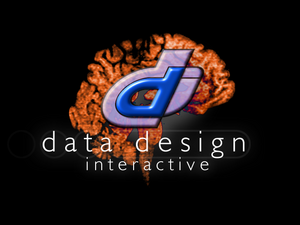
Data Design Interactive was a British video game company. Founded in 1983 by Stewart Green as Data Design Systems, the company started off creating budget software for the ZX Spectrum.
History
Formation
I decided I wanted to break into the budget software market — I think the software industry could be killing itself with the £10 game. Budget software like Cascade's 50 Games compilation, has got to be value for money — if you only play each game on a 50 game compilation for ten minutes, then you’ve had over a day’s solid entertainment.
Stewart Green, CRASH[1]
Data Design Systems was founded in 1983 by Stewart Green.[1][2][3] The previous year had seen the release of the ZX Spectrum, an 8-bit home computer that would go on to sell over five million units. While the Spectrum had inferior hardware compared to its competitors like the Commodore 64 and the BBC Micro, the low cost of both the computer and its cassette-based games led to it becoming a successful gaming platform in the United Kingdom.[4] Green had purchased a Spectrum soon after its release, and had spent his free time learning how to program on it before leaving his engineering apprenticeship to pursue a career in software development. He attempted to sell two of his earliest games, Alien and Bomber, for £2 each at computer shows. After selling only a small number of copies, he decided that a compilation of multiple games on one cassette tape would sell better than individual games, as well as allow him to charge a higher price for the tape and let shops take in a larger profit margin.[1]
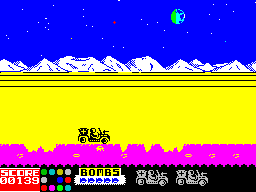
Green applied for the UK government’s Enterprise Allowance Scheme, an initiative which gave an income of £40 per week for one year to anyone unemployed who wanted to set up their own business and had £1000 of their own funds to invest in the project.[1][5] Deciding to develop for the budget software market, he began work on Astrocade, a collection of six games on one tape. While programming it, he learned how to run a business from three free interviews with the Business Advice Centre that the Enterprise Allowance Scheme gave him. Green wanted the compilation to be sold in a large package; he initially planned to use the same cardboard boxes that Beyond Software games used, before he found out that the cardboard dies for that would cost at least £800 and decided to use video boxes instead. Not wanting to pay "hundreds of pounds for a simple piece of artwork," Green got an art student from a local school to create box art for free as portfolio work. Getting game screenshots took two weeks due to the photographer hired not knowing how to take photographs of a television screen.[1]
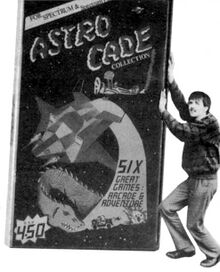
Development of The Astrocade Collection concluded in late 1985.[2][6] It contained three previously-developed games: Alien, a fixed shooter game, Bomber, a City Bomber-like game, and Luna-Rover, a Moon Patrol clone; as well as three original games: Caverns d'Or, an adventure game, Simeon, a Simon clone, and Zombies, an action game.[7][8] The collection's development ended up costing £3000. Green priced Astrocade at £4.50, but had difficulty distributing it; most distributors did not respond to him, and Smith's wanted the the product to have a barcode, which would cost him another £100. He initially sold copies of Astrocade by offering them on sale at local computer shops.[1] Lacking a budget for advertising, he sent copies of the collection packaged with a Mars bar to computer magazines to encourage reviews.[9] An earlier version of Alien was also published as type-in machine code in the February 1986 issue of Your Sinclair.[10] Graeme Kidd from the ZX Spectrum magazine CRASH interviewed Stewart Green at Data Design, which at the time was operated out of the front room of his house in Halesowen. The interview was published in the May 1986 issue of CRASH; by that point, Green had sold only around one hundred copies of Astrocade.[1] Following this, Green advertised the collection through various computer magazines, giving an address for viewers to mail order the game from.[7]
The Astrocade Collection received mixed reviews from contemporary magazines. Reviewers criticised the quality and originality of the games in the collection, though were more positive about the collection's low price and the overall value per game, as well as about the collection being Data Design's first major publication.[7][8][11][12] Stewart Green responded with appreciation for the reviews, though he disagreed with the originality of the games being an issue ("How many Exploding Fists are there now?") and criticised Popular Computing Weekly's claim that Luna-Rover had graphics resembling those of a ZX81 game.[13] From July 1986 onward, Data Design lowered the cost of Astrocade to £1.99 (plus 40p for postage and packaging).[14][15]

Green intended for Astrocade to supply him with funds while he developed a larger project. He announced the development of a play-by-mail game in his interview with CRASH; Green believed that the previous summer had been the last chance for self-employed developers to start in the software market, and claimed that small software developers offered the best service for play-by-mail games.[1] Other Spectrum software Green developed and released during 1985–1986[2] included Death Duel, a Tron-inspired Snake game,[16] Invadas, a Galaxian clone,[17] Space Fright, a remake of his earlier game Alien,[18] and Elite Editor, an editor for the ZX Spectrum version of David Braben and Ian Bell's Elite.[19][20] Data Design Systems also published programs for ZX Spectrum software development, including BASIC +, a collection of six programs for writing software in BASIC, in 1986,[20][21] and Sprite Designer, Printer, and 64 Column Display in 1987.[22] BASIC + was originally released for £5.99,[20] later increased to £12;[21] following the release of the other three programs it was priced at £10 while the others were available for £6 each, or all four could be purchased together for £14.[22]
Freelance programming
In his interview with CRASH, Stewart Green expressed concern that he may have to take up freelance work to survive as a small software house.[1] Following the interview, Green moved on to developing for other companies, particularly strategy games, which he enjoyed playing and programming. Many of his first freelance jobs were for Personal Software Services.[23]
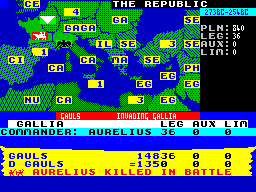
One of Green's first freelance jobs was programming the ZX Spectrum version of Annals of Rome,[23][2] a turn-based strategy game that puts the player in control of the Roman army's military conquests over the course of centuries.[24] The game was designed by Dr. George Jaroszkiewicz, who wanted to create a historical simulation as an "exercise in socio-economic modelling."[25][26] Jaroszkiewicz originally programmed the game for Amstrad CPC 464, and Personal Software Services hired other programmers to convert it to other home computer platforms.[26][27] Believing that video games were seen as "not something for grown men to dabble in," Jaroszkiewicz left his name out of the game, using the alias "Rome Software" instead; Green's Spectrum port, however, credits Jaroszkiewicz (as E.M. Jaroszkiewicz) as its designer in-game.[26][28] The game released in November 1986.[29] CRASH's Philippa Irving rated the Spectrum version of Annals of Rome positively, praising its attention to detail, but criticised its presentation and long periods of waiting during combat, as well as its "entertaining" bugs.[24][27] Tommy Nash of Your Sinclair likewise criticised its speed, which he blamed on it being programmed in BASIC, and called its interface "incomprehensible."[30] Steve Badsey of Computer + Video Games preferred the Spectrum version's graphics over those of the later Commodore 64 release, but reported that it had numerous bugs and frequently generated "impossibly large armies", which PSS allegedly blamed on the Spectrum's random number generator.[31]
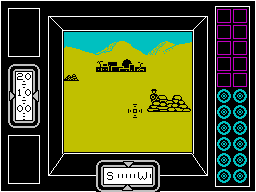
Data Design worked on the Spectrum version of Alan Steel's Tobruk.[2] The game is a simulation of the 1942 Battle of Gazala and subsequent Axis capture of Tobruk. The player controls the Axis forces of German field marshal Erwin Rommel; a second player can play as the British forces. During combat, the player can enter an arcade sequence and control a tank in first-person view.[32][33] Stewart Green designed and programmed the action sequence in the game's Spectrum versions.[23] Tobruk released on Spectrum in September 1986.[34] Computer Gamer called Tobruk "one of the most enjoyable wargames."[32] Philippa Irving found the game uninteresting, and was particularly negative towards its arcade mode, which she called "stunningly badly designed and unplayable."[33] Green later commented that she must have appreciated his work due to her accidentally labelling screenshots of Tobruk as Vulcan.[23] Gary Rook of Sinclair User found the game disappointing and its arcade mode "clumsily executed."[35] ZX Computing Monthly stated the arcade sequence worked well and praised the game overall.[36]
Green redesigned and programmed Pegasus Bridge for both ZX Spectrum and Amstrad CPC from the original Commodore 64 version.[23][37][38] Originally designed by John Bethell, who had previously created Falklands '82,[37][27] Pegasus Bridge is based on the titular bridge's capture by the British 6th Airbone Division early on 6 June 1944, preceding the Normandy landings.[39][38] The player can control either the British troops, landing and capturing bridges and the Merville Battery, or the German army, defending as many positions as possible from capture for the game's 36 turns.[39][40][41] Pegasus Bridge released in October 1987.[42] CRASH's Philippa Irving praised the Spectrum version's design and gameplay, but found it "annoyingly difficult" to control with a keyboard,[27] and later admitted to encountering a bug that crashed the game prevented her from completing it.[43] Sinclair User gave the game a positive review, criticising only the small size of the map window.[44] Owen and Audrey Bishop of Your Sinclair called the game well-researched, but complained about a bug in the Spectrum version that switched which side the player was controlling, as well as the fast speed of in-game messages.[40] Amstrad Action called the Amstrad version boring, and criticised the lack of sound and sensitive controls.[41]
In 1987 Green began developing Invasion Force, an original strategy game set during World War II.[2][45] The game does not simulate any specific battle, and each side is labelled only as blue or red. The game is divided into fifteen missions; for each one players select which units they will use, choose where to deploy them, and command them around the map to complete the given objective. Player one controls the invading blue army, and player two or the computer tries to stop them as the red army. The game is heavily depended on its instruction manual, as each mission objective must be decoded using the code sheet found in it.[46][45] Invasion Force was published by Cases Computer Simulations for ZX Spectrum in February 1990.[47] An Amstrad CPC version was planned, but was never released.[48] The game received positive reviews. Mark Caswell of CRASH asserted that players new to strategy would find it easy to pick up.[46] Inversely, Jonathan Davies of Your Sinclair recommended it for experienced strategy game players looking for a new experience.[45]
References
- ↑ a b c d e f g h i Kidd, Graeme (May 1986). "This Little Proggy Went To Market...". CRASH - The Online Edition. No. 28. Newsfield Publications Ltd. p. 76. Archived from the original on 25 June 2023.
- ↑ a b c d e f History. datadesign.uk.com. Data Design Interactive. Archived from the original on 16 December 2004.
- ↑ Younghusband, Paul (February 2001). "A One Stop Digital Shop: Data Design Interactive and Artworld UK". Animation World Magazine. Vol. 5, No. 11. AWN, Inc. Archived from the original on 18 January 2023. Mirror available at Animation World Network.
- ↑ Mason, Graeme (18 February 2022). "ZX Spectrum at 40: a look back". NME. Archived from the original on 23 June 2023.
- ↑ Dellheim, Charles (1 July 1996). "Thatcher's Self Employment". Inc. Archived from the original on 15 April 2003. Retrieved 25 June 2023.
- ↑ Green, Stewart (1 November 1985). Alien (ZX Spectrum) (Astrocade version). Data Design Systems. Title screen. "© 1.11.85".
- ↑ a b c Phillips, Max (July 1986). "Screen Shots". Your Sinclair. Issue 7. Sportscene Specialist Press. p. 61.
- ↑ a b Kidd, Graeme (June 1986). "The Games Gatherings". CRASH. No. 29. Newsfield Publications Ltd. pp. 98–99.
- ↑ Mangram, Lloyd (April 1986). "Merely Mangram". CRASH. No. 27. Argus Specialist Publications. p. 112.
- ↑ Cox, Kevin (ed.) (February 1986). "Alien by Stewart Green". Your Sinclair. Issue 2. Sportscene Specialist Press. pp. 48–52.
- ↑ Taylor, Graham (1 May 1986). "New releases". Popular Computing Weekly. Vol. 5 No. 18. Sunshine Publications. pp. 44–45.
- ↑ Hetherington, Tony (June 1986). "Adventure Reviews". Computer Gamer. No. 15. Newsfield Publications Ltd. p. 39.
- ↑ Green, Stewart (26 June 1986). "Review reaction". Popular Computing Weekly. Vol. 5 No. 26. Sunshine Publications. p. 10.
- ↑ Astrocade advertisement. Computer Gamer. No. 16, July 1986. Newsfield Publications Ltd. p. 29.
- ↑ South, Phil (September 1986). "Frontlines". Your Sinclair. Issue 9. Sportscene Specialist Press. p. 5.
- ↑ Cox, Kevin (ed.) (April 1986). "Death Duel". Sinclair User. No. 49. EMAP. pp. 99–100.
- ↑ Cox, Kevin (ed.) (July 1986). "Invadas by Stewart Green". Your Sinclair. Issue 7. p. 48.
- ↑ Evans, Gary (ed.) (May 1986). "Software Exchange". Your Computer. Vol. 6 No. 5. Focus Investments Ltd. p. 66.
- ↑ Green, Stewart (August 1986). "Six games for £1.99" ad. CRASH. No. 31. Newsfield Publications Ltd. p. 59.
- ↑ a b c Green, Stewart (September 1986). "Data Design" ad. Your Sinclair. Issue 9. p. 93.
- ↑ a b Green, Stewart (January 1987). "Data Design" ad. Your Sinclair. Issue 13. Sportscene Specialist Press. p. 123.
- ↑ a b Green, Stewart (February 1987). "D.D.S. The Programming Specialists" ad. Your Sinclair. Issue 14. Sportscene Specialist Press. p. 100.
- ↑ a b c d e Irving, Philippa (July 1988). "Frontline with Philippa Irving". CRASH - The Online Edition. No. 54. Newsfield Publications Ltd. p. 63. Archived from the original on 28 June 2023.
- ↑ a b Irving, Philippa (March 1987). "Frontline with Philippa Irving". CRASH. No. 38. Newsfield Publications Ltd. p. 63.
- ↑ Frey, Oliver (ed.) (August 1988). "All This and Barbarians Too". The Games Machine. Issue 9. Newsfield Publications. p. 60.
- ↑ a b c Goodfellow, Troy (17 March 2008). "Annals of Rome – The Designer’s Perspective". Flash of Steel. Archived from the original on 28 June 2023.
- ↑ a b c d Irving, Philippa (December 1987). "Frontline with Philippa Irving". CRASH. No. 47. Newsfield Publications Ltd. pp. 48–49.
- ↑ Douglas, Jim (January 1987). "What is it Good For?". Sinclair User. No. 58. EMAP. p. 124.
- ↑ Nash, Tommy (February 1987). "Annals of Rome". Your Sinclair. Issue 14. Sportscene Specialist Press. p. 85.
- ↑ Badsey, Steve (January 1988). "Annals of Rome". Computer + Video Games. Issue 76. Future Publishing. p. 46.
- ↑ a b A.H. (May 1987). "Tobruk". Computer Gamer. No. 26. Newsfield Publications Ltd. p. 71.
- ↑ a b Irving, Philippa (May 1987). "Frontline with Philippa Irving". CRASH. No. 40. Newsfield Publications Ltd. pp. 101–102.
- ↑ Edgeley, Clare (August 1986). "Software Preview". Sinclair User. No. 53. EMAP. p. 98.
- ↑ Rook, Gary (June 1987). "Tobruk". Sinclair User. No. 63. EMAP. p. 99.
- ↑ Ralph, Bryan (ed.) (May 1987). "Tobruk". ZX Computing Monthly. Argus Specialist. p. 45.
- ↑ a b Green, Stewart (1986). Pegasus Bridge (ZX Spectrum; Amstrad CPC). Data Design Systems. Credits. "Idea by John Bethell. Conversion by DSS. Published by.. PSS. Programmer... STEWART GREEN".
- ↑ a b Badsey, Steve (June 1988). "Pegasus Bridge". Computer + Video Games. Issue 80. Future Publishing. p. 54.
- ↑ a b Irving, Philippa (January 1988). "Frontline with Philippa Irving". CRASH. No. 48. Newsfield Publications Ltd. p. 136.
- ↑ a b Bishop, Owen; Bishop, Audrey (March 1988). "On the War Path". Your Sinclair. Issue 27. Sportscene Specialist Press. pp. 54–55.
- ↑ a b Barrett, Gary (December 1987). "Pegasus Bridge". Amstrad Action. No. 27. Future Publishing. p. 52.
- ↑ Dean, Stephen (2 October 1987). "New releases". Popular Computing Weekly. Vol. 6 No. 39. Sunshine Publications. p. 43.
- ↑ Irving, Philippa (April 1988). "Frontline with Philippa Irving". CRASH. No. 51. Newsfield Publications Ltd. p. 51.
- ↑ Rook, Gary (February 1988). "Pegasus Bridge". Sinclair User. No. 71. EMAP. p. 74.
- ↑ a b c Davies, Jonathan (March 1990). "Invasion Force". Your Sinclair. Issue 51. Sportscene Specialist Press. p. 55.
- ↑ a b Caswell, Mark (March 1990). "Invasion Force". CRASH. No. 74. Newsfield Publications Ltd. p. 42.
- ↑ Caswell, Mark (February 1990). "Cannons, Charges, Strategies...". CRASH. No. 73. Newsfield Publications Ltd. p. 28.
- ↑ "INVASION FORCE (c) CCS". CPCrulez. Archived from the original on 3 July 2023.
